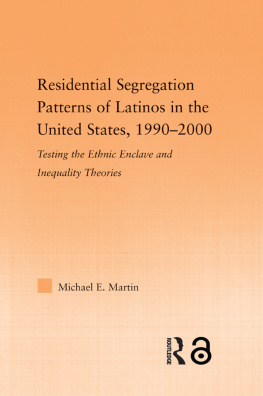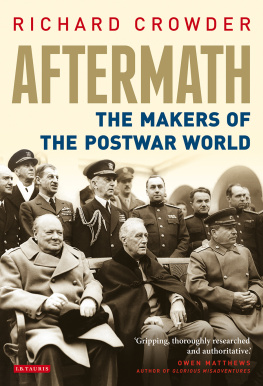CYCLE OF SEGREGATION
Social Processes and Residential Stratification
Maria Krysan and Kyle Crowder
Russell Sage Foundation
New York
The Russell Sage Foundation
The Russell Sage Foundation, one of the oldest of Americas general purpose foundations, was established in 1907 by Mrs. Margaret Olivia Sage for the improvement of social and living conditions in the United States. The foundation seeks to fulfill this mandate by fostering the development and dissemination of knowledge about the countrys political, social, and economic problems. While the foundation endeavors to assure the accuracy and objectivity of each book it publishes, the conclusions and interpretations in Russell Sage Foundation publications are those of the authors and not of the foundation, its trustees, or its staff. Publication by Russell Sage, therefore, does not imply foundation endorsement.
Library of Congress Cataloging-in-Publication Data
Names: Krysan, Maria, author. | Crowder, Kyle, author.
Title: Cycle of segregation : social processes and residential stratification / Maria Krysan and Kyle Crowder.
Description: New York : Russell Sage Foundation, [2017] | Includes bibliographical references and index.
Identifiers: LCCN 2017029335 (print) | LCCN 2017032595 (ebook) | ISBN 9781610448697 (ebook) | ISBN 9780871544902 (pbk. : alk. paper)
Subjects: LCSH: Social changeUnited States. | Social stratificationUnited States. | SegregationUnited States.
Classification: LCC HN59.2 (ebook) | LCC HN59.2 .K79 2017 (print) | DDC 303.40973dc23
LC record available at https://lccn.loc.gov/2017029335
Copyright 2017 by Russell Sage Foundation. All rights reserved. Printed in the United States of America. No part of this publication may be reproduced, stored in a retrieval system, or transmitted in any form or by any means, electronic, mechanical, photocopying, recording, or otherwise, without the prior written permission of the publisher.
Reproduction by the United States Government in whole or in part is permitted for any purpose.
The paper used in this publication meets the minimum requirements of American National Standard for Information SciencesPermanence of Paper for Printed Library Materials. ANSI Z39.48-1992.
Text design by Suzanne Nichols.
RUSSELL SAGE FOUNDATION
112 East 64th Street, New York, New York 10065
10 9 8 7 6 5 4 3 2 1
The ghetto is self-perpetuating, for by separating the white child from the Negro child we hand on to both our own dear delusions of race. We are now trapped in a situation where we must push for a miscellany of tortuous techniques, from pairing to busing, designed to integrate schools which serve segregated neighborhoods, both black and white. These schools must pretend that Americans live in one world and not two, but the children know better because they know their neighborhoods. The bus from the Negro ghetto in Evanston, Illinois, comes every morning to Lincolnwood elementary school, and the white children on the playground shout, Here comes the colored bus!
Neighborhood segregation is thus the sour grape that sets each new generations teeth on edge. Right now we are creating another generation of Americans committed in their bones to segregation, not because we are formally teaching it (in many homes and schools we are teaching just the opposite), but because we are living it.
National Committee Against Discrimination in Housing,
How the Federal Government Builds Ghettos
Contents
List of Illustrations
About the Authors
M ARIA K RYSAN is professor in the Department of Sociology and the Institute of Government and Public Affairs at the University of Illinois at Chicago.
K YLE C ROWDER is Blumstein-Jordan Professor of Sociology at the University of Washington.
Acknowledgments
T HIS BOOK IS the culmination of years of telephone conversations, emails, and meetings between the two authors. Kyle planted the seed. The ideas, data, and arguments were nurtured, modified, developed, and cultivated by these countless exchanges. And the book finally came to pass because of Marias persistence. From start to finish, this was a collaboration; both authors contributed equally to the manuscript.
We are deeply indebted to thoughtful contributions to this work from many generous colleagues, all of whom helped us develop and strengthen the ideas and our presentation of them. Our collaborator, Michael Bader, deserves special thanks for his intellectual contributions over many years and especially for a careful read of an early draft that gave us insightful restructuring advice. In addition, we are particularly grateful to Stew Tolnay and several anonymous reviewers who also read early drafts of the book and pushed us to refine our arguments. We thank Erin Carll, Chris Hess, and Max Cuddy who provided careful research assistance.
The research in this book was supported, in part, by a grant to the authors from the National Science Foundation (Grant #1324039), and from a Eunice Kennedy Shriver National Institute of Child Health and Human Development research infrastructure grant, R24 HD042828, to the Center for Studies in Demography and Ecology at the University of Washington. The 2003 in-depth interviews and focus groups were a collaboration between Maria and Mick P. Couper, Reynolds Farley, and Tyrone Forman. These, and the 2012 in-depth interviews, were made possible by funding from the Office of Social Science Research, Campus Research Board, and the Institute for Research on Race and Public Policy (IRRPP), all at the University of Illinois at Chicago (UIC). A team of then-graduate students at UIC, including Rhonda Dugan, Vickey Velazquez, Jody Ahlm, Patrick Washington, and Melissa Abad conducted the interviews, and UICs Survey Research Laboratory recruited respondents and provided needed facilities for the data collection. IRRPP also provided crucial fellowship support and a writing retreat for Maria; and in April 2015, the Schragg Family Fellowship provided support for Maria to spend a week of writing-in-residence at the University of Washington.
Kyle is deeply indebted to the members of the Context Working Group at the University of Washingtonincluding Jerry Herting, Hedy Lee, Stew Tolnay and a host of brilliant graduate studentsfor countless enlightening conversations about neighborhood dynamics and the drivers of segregation. He is also exceedingly thankful for the endurance of his wife, Robin, and sons, C.J. and Finn, for their unwavering support, grounding, and humor as we worked on this book. Finally, special thanks goes to Kyles mother, Karen, for providing early and consistent reminders of the importance of racial justice.
Maria is grateful to: the graduate student members of UICs Neighborhoods, Housing, and Urban Sociology reading group who were a source of energy and a sounding board; the faculty and staff in the Department of Sociology who are a great intellectual community engaged in scholarship that makes a difference (special thanks to Tara Gordon-Williams and Jennifer Michals for helping protect Marias time); Paula Dempsey, the amazingly helpful sociology librarian at UIC; and the many housing agency and non-profit professionals (especially Rob Breymaier and the Oak Park Regional Housing Center) she has interacted with through her work at the Institute of Government and Public Affairs. They have kept her grounded in the realities of segregation, the processes that perpetuate it, and the efforts to upend it.







